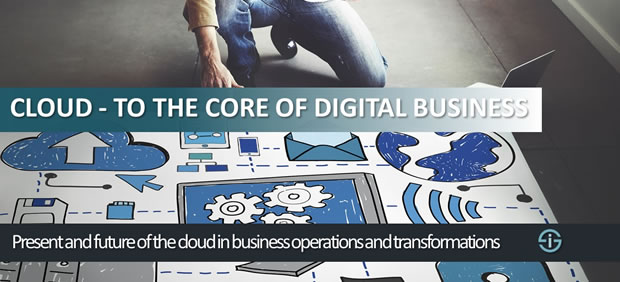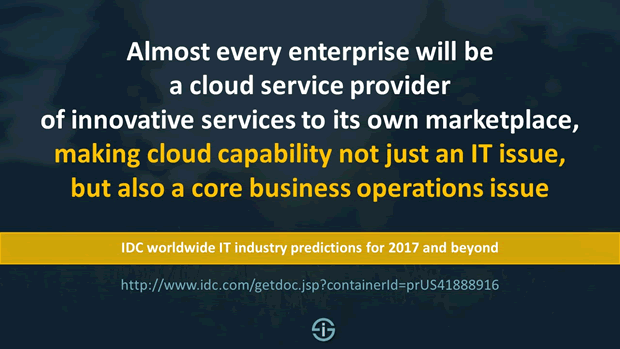A key pillar of the digital transformation technology ecosystem without a doubt is cloud computing and it’s in this context that the future of the cloud needs to be seen.
Just like another digital transformation technology ecosystem which we covered in the scope of digital transformation, IoT, cloud computing is again an umbrella term, with several technologies, components, approaches and types of applications in an increasingly multi-cloud reality.
Where the main drivers for cloud adoption de facto often still revolve around traditional benefits such as moving from a CapEx to an OpEx environment, in a context of digital transformation other benefits and drivers are far more important and shape the future cloud priorities and deployments. Cloud computing is not just a pillar of transformation, it also is in transformation.

Cloud as the key enabler of transformation
The cloud is the foundational enabler of digital transformation projects and offers the scale and speed that is needed for businesses to focus on transformation; with a clear impact on the role of the IT department.
As business executives are increasingly involved in taking IT buying decisions (in practice this often concerns cloud-based solutions) and as IT increasingly needs to enable the possibilities to develop, deploy, deliver and scale fast, cloud computing isn’t just seen as the on-demand delivery of applications (SaaS or Software as a Service) or just a bolt-on phenomenon anymore.
Cloud simply is essential for fast exection and informed decision making, building bridges for actionable intelligence as mentioned in our article on digital transformation strategy.
Dealing with legacy IT to transform
Today, the focus is on Enterprise IT and how we deal with data and information overall, including performance management and security in the cloud.
Cloud is ever more about moving away from legacy IT (with even business-critical infrastructure moving to the public cloud), whereby the CIO becomes an orchestrator of a hybrid cloud reality in a multi-cloud environment.
In practice this is also changing the cloud market and the future of the cloud as we go from ‘cloud first’ to ‘cloud only’ (which doesn’t mean that only cloud will exist in the near future but that more investments and deployments are cloud-only) and organizations outsource many cloud and IT activities, seek managed services and most of all want reliable cloud partners who have a real hybrid cloud offering (which means seamless integration) with all the needs of visibility and controls this offers the CIO.
The DX business model and the future of the cloud: almost every enterprise a cloud service provider?
Again, many organizations are not there yet but it’s clear that in a digital transformation economy hybrid cloud and multi-cloud architectures are going to take the lead and organizations start building fully cloud-enabled services themselves in the scope of a specific activity.
We see this for instance in the Industrial Internet of Things where some companies have strong cloud-based platforms which are then sold to their customers who leverage them to develop and deploy IoT projects fast, taking into account all the requirements of advanced (Industrial) Internet of Things initiatives. As IDC says, this is what the future of the cloud will bring: enterprises which become cloud service providers of innovation to their own marketplace.

The future of the cloud today: the example of the Schneider Electric EcoStruxure IoT platform
To make this transformational future cloud model in the business sense more tangible it suffices to look at an example of today, in smart buildings, smart cities, smart grid and Industrial Internet space: France-based energy management and automation expert Schneider Electric.
Schneider Electric operates a platform, which it called the EcoStruxure Platform, and is the end-to-end Internet of Things technology backbone of the company. It offers a set of technological capacities that enable to connect the three layers of innovation in IoT-enabled solutions as Schneider Electric puts it.
The three key capabilities of the EcoStruxure IoT platform are 1) embedded connectivity and intelligence, 2) an interoperable foundation for smart operations and 3) an infrastructure for cloud-connected digital services.
EcoStruxure bridges the IT and OT gap, which is essential in the Industrial Internet of Things and Industry 4.0. The architecture and platform enables the delivery of IoT-enabled solutions at scale and faster for smart buildings, grids, the industry and data centers. EcoStruxure uses Microsoft’s Azure as the cloud backbone to deliver its digital services, analytics and so forth.

Yet, as the platform provides its users with digital services that connect the equipment and software to the cloud, using IoT technology, it is an example of what we mean with this future of the cloud as IDC forecasts it.
Regarding digital services, you can for instance think leveraging big data analytics and mobility to provide customers with actionable intelligence, which can be used to improve automation. With its actionable intelligence approach, Schneider Electric’s EcoStruxure closes the loop from connections of IoT devices to the collection of data, the analysis of this data, and, finally, the usage of real-time information and business logic to take action and optimize operations.
The omni-presence of the cloud in digital transformation technologies
Certainly there aren’t that many examples of companies who are so far already and not every company can move in that direction but it’s clear that in the future, cloud will take a more important place in your business transformation too, with a leading role for hybrid cloud.
The key aspect to remember in a context of digital transformation though is that cloud is simply essential and the future of the cloud is transformational.
Moreover, is there any technology which we use in this perspectve of transformation and innovation that can do without the cloud?
From the Internet of Things, analytics, systems of insight, security at the edge to mobile/mobility and big data: there is always the omni-presence of cloud. And for those who like to talk about disruptive offerings or disruptive entrants in existing markets: have you ever seen one that wasn’t based on the cloud?
Top image: Shutterstock – Copyright: Rawpixel.com – All other images are the property of their respective mentioned owners.

